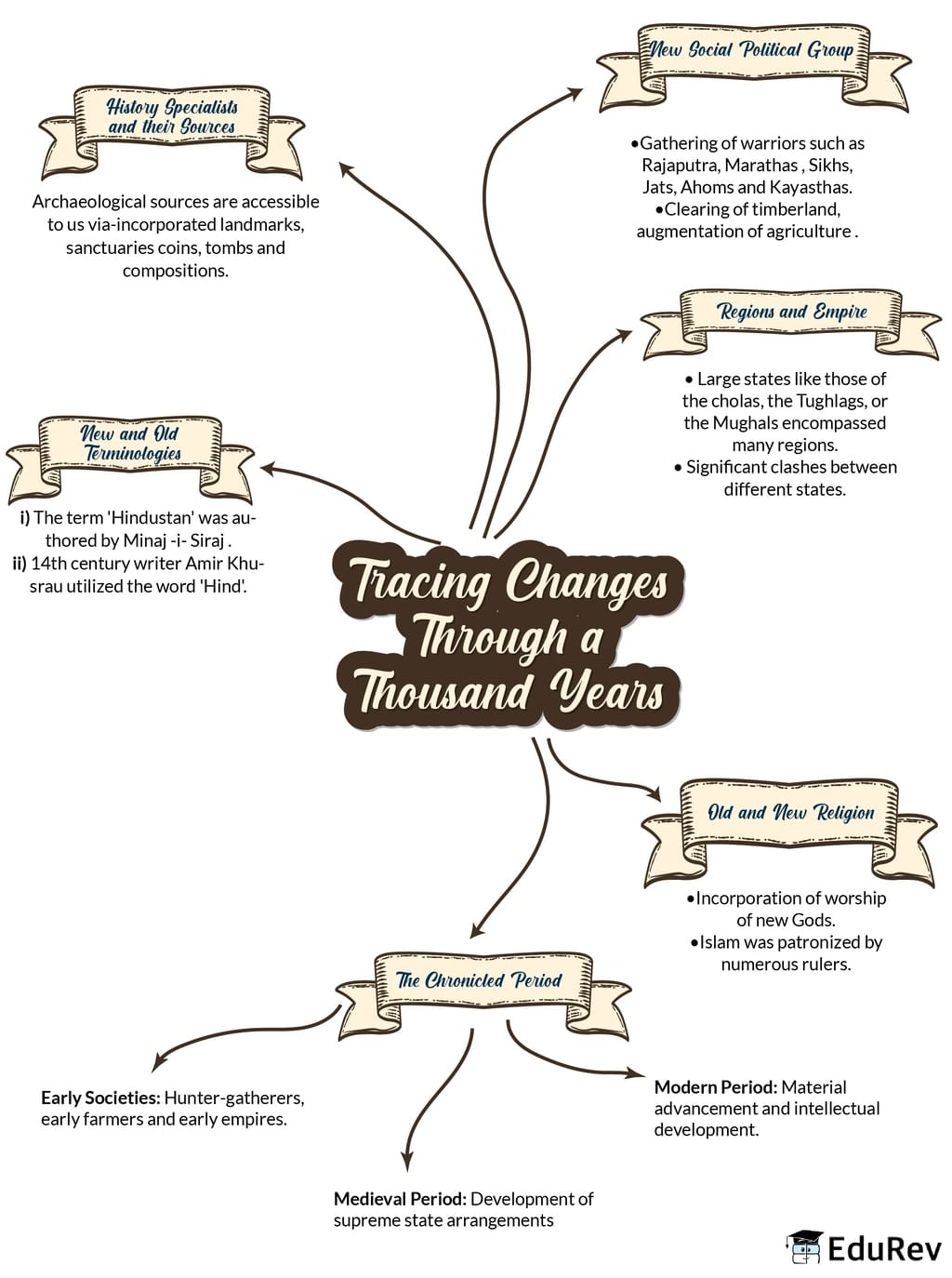Class 7 Exam > Class 7 Notes > Social Studies (SST) Class 7 > Mindmap: Tracing Changes Through A Thousand Years
Mindmap: Tracing Changes Through A Thousand Years | Social Studies (SST) Class 7 PDF Download

The document Mindmap: Tracing Changes Through A Thousand Years | Social Studies (SST) Class 7 is a part of the Class 7 Course Social Studies (SST) Class 7.
All you need of Class 7 at this link: Class 7
|
62 videos|336 docs|46 tests
|
FAQs on Mindmap: Tracing Changes Through A Thousand Years - Social Studies (SST) Class 7
| 1. How did society change over the course of a thousand years? |  |
Ans. Society underwent significant changes over the course of a thousand years. These changes encompassed various aspects such as culture, technology, politics, and demographics. For instance, feudal societies gave way to more centralized and organized governments, while technological advancements like the printing press revolutionized communication and knowledge dissemination. Additionally, the demographic landscape shifted as urbanization and economic development led to changes in population distribution and lifestyle.
| 2. What were the key factors that drove societal changes over a thousand years? |  |
Ans. Several factors played pivotal roles in driving societal changes over a thousand years. Key factors include technological advancements, political transformations, economic shifts, cultural exchange, and environmental factors. Technological innovations such as the steam engine, electricity, and the internet transformed various aspects of society. Political changes, such as the rise and fall of empires, led to shifts in power structures and governance systems. Economic factors, such as the Industrial Revolution, accelerated societal changes by altering modes of production and labor relationships. Cultural exchange through trade, exploration, and migration influenced societal norms and values. Lastly, environmental factors, like climate change or natural disasters, also impacted societies.
| 3. How did religion evolve over the course of a thousand years? |  |
Ans. Religion went through significant transformations over a thousand years. The dominant religious beliefs and practices varied across different regions and time periods. For example, during the early Middle Ages, Christianity played a central role in European society, while Islam flourished in the Islamic Golden Age. The Protestant Reformation in the 16th century led to the fragmentation of Christianity and the emergence of new religious denominations. Additionally, the spread of Buddhism, Hinduism, and other Eastern religions influenced societies in Asia. Religious institutions and doctrines also adapted and evolved in response to societal changes, scientific advancements, and cultural shifts.
| 4. How did global trade and exploration impact societies over a thousand years? |  |
Ans. Global trade and exploration had profound impacts on societies over a thousand years. The expansion of trade networks, such as the Silk Road or the Trans-Saharan trade routes, facilitated the exchange of goods, ideas, and technologies between different regions. These exchanges sparked cultural diffusion, leading to the adoption of new practices, technologies, and belief systems. Furthermore, the Age of Exploration in the 15th and 16th centuries opened up new trade routes and expanded European colonial empires, which brought about significant economic, political, and social changes around the world. Global trade and exploration also played a role in shaping power dynamics, fostering imperial rivalries, and initiating processes of globalization.
| 5. How did the role of women change over a thousand years? |  |
Ans. The role of women experienced significant changes over a thousand years, although the extent and nature of these changes varied across different regions and time periods. In many pre-modern societies, women were primarily confined to domestic roles and had limited access to education, political power, or economic opportunities. However, movements for women's rights and societal changes gradually challenged these norms. For example, the suffrage movement in the late 19th and early 20th centuries fought for women's right to vote, leading to increased political participation. Industrialization and urbanization also opened up new opportunities for women in the workforce. Social and cultural shifts, such as the feminist movement, challenged traditional gender roles and advocated for gender equality. Nonetheless, it is important to note that progress in women's rights has been uneven and continues to be a topic of ongoing struggle in many societies.

|
Explore Courses for Class 7 exam
|

|
Signup for Free!
Signup to see your scores go up within 7 days! Learn & Practice with 1000+ FREE Notes, Videos & Tests.
Related Searches


















